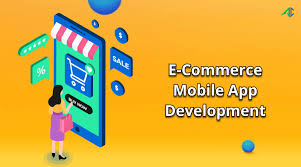In today’s digital landscape, e-commerce apps have become essential tools for businesses that want to connect with their customers, drive sales, and create a seamless shopping experience. However, simply having an app isn’t enough. The key to success lies in developing an app that not only attracts users but also converts them into paying customers. Conversion is the ultimate goal for any e-commerce platform, and achieving high conversion rates can make or break a business.
In this article, we’ll reveal the secret to creating a high-converting e-commerce app, focusing on strategies that will boost user engagement, enhance customer satisfaction, and ultimately, increase your revenue. Whether you’re working with an e-commerce app development company or building your app in-house, these insights will help you craft an app that stands out in the crowded marketplace.
1. Seamless User Experience (UX)
User experience is the foundation of any successful e-commerce app. If users find it difficult to navigate your app or experience slow load times, they’ll quickly leave and may never return. A seamless, intuitive, and user-friendly interface is the cornerstone of high conversions.
Optimized Navigation
Make sure your app’s navigation is simple and easy to follow. Users should be able to find what they’re looking for in just a few taps. Use clear categories, a robust search function, and filters that help customers narrow down their choices.
Fast Load Times
A delay of just a few seconds can significantly reduce your conversion rates. According to research, if a mobile app takes longer than three seconds to load, users are likely to abandon it. Partnering with an experienced e-commerce app development company ensures that your app is built to be fast and efficient, reducing the chances of losing potential customers due to slow performance.
Streamlined Checkout Process
One of the main reasons users abandon their shopping carts is a complicated checkout process. Make sure your checkout is quick, easy, and secure. Include features like auto-fill for user information, multiple payment options, and a guest checkout option to reduce friction during the purchase.
2. Mobile-First Design
With the majority of consumers shopping on their smartphones, having a mobile-first design is crucial. A well-optimized mobile app enhances the user experience by offering smooth functionality and usability on smaller screens.
Responsive Design
Ensure that your app is responsive, meaning that it adapts to different screen sizes and orientations. Whether a user is shopping on a smartphone or a tablet, the experience should be seamless. A skilled e-commerce app development company will prioritize responsive design to ensure your app functions perfectly across all devices.
Finger-Friendly Interface
Mobile shoppers interact with their devices differently than desktop users. Incorporate large, easy-to-tap buttons and ensure there’s enough space between interactive elements to prevent misclicks. This improves usability and reduces frustration.
Voice Search and AI Integration
Voice search is gaining popularity, especially among mobile users. Incorporating voice search functionality and AI-powered product recommendations into your app can make it easier for users to find what they want, improving their shopping experience and increasing the likelihood of conversion.
3. Personalization
Personalization is a powerful tool for increasing conversions. Customers are more likely to purchase if they feel the app is tailored to their preferences and needs.
Behavior-Based Recommendations
Using customer data, such as past purchases, browsing behavior, and wishlists, allows you to offer personalized product recommendations. For example, if a user frequently purchases skincare products, your app can highlight related items during their visit. An e-commerce app development company can help integrate algorithms that deliver these personalized recommendations in real-time.
Personalized Push Notifications
Push notifications are a great way to re-engage users who haven’t visited your app in a while. However, it’s essential to personalize these notifications. Sending relevant offers based on a user’s previous behavior, such as discounts on items they’ve shown interest in, can significantly increase conversion rates.
Dynamic Content
The content on your app’s home screen should be dynamic and change based on the user’s behavior. For example, showing a customer products related to their previous searches or highlighting sales on categories they’ve browsed will make the shopping experience feel more personalized and engaging.
4. Secure and Diverse Payment Options
Security is a top concern for online shoppers. Customers need to feel confident that their personal and financial information is safe when making a purchase through your app. Additionally, offering multiple payment methods increases the likelihood of conversion by providing users with their preferred payment option.
Encryption and Security Protocols
Ensure that your e-commerce app uses the latest encryption standards and security protocols to protect sensitive customer data. Hiring a reputable e-commerce app development company can help you implement advanced security features such as SSL certificates, two-factor authentication, and fraud detection tools.
Multiple Payment Options
Different customers prefer different payment methods. Offering a variety of options such as credit/debit cards, PayPal, mobile wallets, and even buy-now-pay-later services like Klarna or Afterpay can make the checkout process smoother and increase conversions. Having a trusted e-commerce app development company build and integrate these options ensures they function flawlessly.
5. Social Proof and User Reviews
Shoppers rely heavily on social proof when making purchasing decisions. Incorporating user-generated content, such as reviews and ratings, can help build trust and influence purchasing behavior.
In-App Reviews
Allow users to leave reviews and ratings directly within the app. Highlight these reviews on product pages to give new customers the confidence they need to complete their purchase. Seeing that others have had positive experiences can reassure users and lead to higher conversion rates.
Social Sharing Features
Include social sharing buttons that allow users to share their purchases or wishlists on platforms like Instagram, Facebook, or Twitter. This not only increases brand visibility but also acts as a form of social proof, showing potential customers that your products are popular.
6. Loyalty Programs and Incentives
Incentives such as discounts, promotions, and loyalty programs can be highly effective in driving conversions. Offering rewards for repeat purchases or special deals for app users encourages customers to stay engaged and shop more frequently.
Exclusive App-Only Deals
Offer exclusive discounts or early access to sales for users who shop via your app. This creates a sense of urgency and exclusivity, prompting users to make a purchase. By collaborating with an e-commerce app development company, you can ensure that these features are integrated smoothly into your app.
Gamification and Rewards
Adding a gamification element to your loyalty program, such as earning points for every purchase or completing certain actions within the app, can make shopping more enjoyable and incentivize users to return. For instance, offering a discount after accumulating a certain number of points encourages repeat business.
7. Data-Driven Insights and Continuous Optimization
The secret to maintaining a high-converting e-commerce app is continuous improvement. Data analytics and user feedback are invaluable in identifying areas for optimization.
Tracking Key Metrics
Use analytics to track key performance indicators (KPIs) such as conversion rates, cart abandonment rates, and average order value. By understanding which areas of your app are performing well and which need improvement, you can make data-driven decisions to enhance the user experience. An e-commerce app development company can help you integrate the right analytics tools to gather this data.
A/B Testing
Conduct A/B testing on different elements of your app, such as button placements, product page layouts, and call-to-action wording. Testing different variations allows you to identify which versions result in higher conversions, enabling you to refine your app over time.
User Feedback
Encourage users to provide feedback about their shopping experience through surveys or in-app prompts. Customer insights can help you pinpoint issues that may not be obvious from data alone, allowing you to make necessary improvements to increase satisfaction and conversions.
Conclusion
Creating a high-converting e-commerce app requires a combination of user-centric design, personalized features, secure payment options, and data-driven optimization. By focusing on the elements that matter most to your customers—such as seamless navigation, fast load times, and personalized recommendations—you can build an app that not only attracts users but also converts them into loyal, paying customers.
Partnering with a trusted e-commerce app development company is crucial in executing these strategies effectively. An experienced development team will ensure that your app is built with the latest technology, optimized for mobile devices, and designed to deliver a flawless shopping experience.


